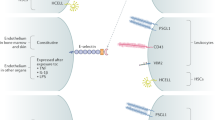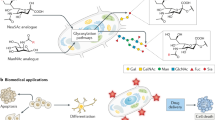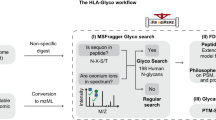Key Points
-
Complex glycans are important modulators of numerous biological processes, ranging from organ development to wound healing to the modification of diseases such as cancer. Although there are some exceptions, glycans do not generally control biological processes in a digital 'on or off' manner; rather, they 'fine-tune' biological functions.
-
Complex glycans are either linear or branched structures that can exist alone or attached to other biomolecules. Owing to variation in branching patterns and in the individual monosaccharides that comprise the chain, glycans are information-dense biomolecules.
-
Recent advances in several areas of research — including the development of analytical techniques, numerous genetic studies, new synthetic strategies and the advent of bioinformatics platforms — have raised the exciting possibility that glycan-based drugs could be developed for many diseases.
-
Structure–function studies in this area have already led to important advances, both scientifically and in terms of drug development. Two examples of the latter are the development of second-generation antithrombotics with increased efficacy and increased clinical usefulness, and the development of improved forms of glycoprotein drugs.
-
The US National Institutes of Health has recently sponsored the development of a consortium that brings together leaders in the field of glycan chemistry and biology to systematically catalogue and study glycan structure and function. This endeavour promises to provide a wealth of important information for the development of novel therapeutics and diagnostics, in a similar way to other federally sponsored initiatives in genomics and proteomics.
Abstract
Complex glycans that are located at the surface of cells, deposited in the extracellular matrix and attached to soluble signalling molecules have a crucial role in the phenotypic expression of cellular genotypes. However, owing to their structural complexity and some redundancy in terms of structures that elicit a function, the therapeutic potential of complex glycans has not been well exploited, with a few notable exceptions. This review outlines recent advances that promise to increase our ability to use complex glycans as therapeutics. Opportunities for the development of further structure–function relationships for these complex molecules are also discussed.
This is a preview of subscription content, access via your institution
Access options
Subscribe to this journal
Receive 12 print issues and online access
$209.00 per year
only $17.42 per issue
Buy this article
- Purchase on Springer Link
- Instant access to full article PDF
Prices may be subject to local taxes which are calculated during checkout




Similar content being viewed by others
References
Varki, A. et al. Essentials of Glycobiology (Cold Spring Harbor Laboratory Press, New York, 1999).
Perrimon, N. & Bernfield, M. Specificities of heparan sulphate proteoglycans in developmental processes. Nature 404, 725–728 (2000). A review of the importance of linear polysaccharides in developmental processes.
Ioffe, E. & Stanley, P. Mice lacking N-acetylglucosaminyltransferase I activity die at mid-gestation, revealing an essential role for complex or hybrid N-linked carbohydrates. Proc. Natl Acad. Sci. USA 91, 728–732 (1994).
Jin, L. et al. The anticoagulant activation of antithrombin by heparin. Proc. Natl Acad. Sci. USA 94, 14683–14688 (1997).
Fu, X. et al. Antibiotic optimization via in vitro glycorandomization. Nature Biotechnol. 21, 1467–1469 (2003).
Iozzo, R. V. Heparan sulfate proteoglycans: intricate molecules with intriguing functions. J. Clin. Invest. 108, 165–167 (2001).
Rudd, P. M., Elliott, T., Cresswell, P., Wilson, I. A. & Dwek, R. A. Glycosylation and the immune system. Science 291, 2370–2376 (2001).
Alper, J. Glycobiology. Turning sweet on cancer. Science 301, 159–160 (2003).
Lowe, J. B. & Marth, J. D. A genetic approach to mammalian glycan function. Annu. Rev. Biochem. 72, 643–691 (2003).
Kusche-Gullberg, M. & Kjellen, L. Sulfotransferases in glycosaminoglycan biosynthesis. Curr. Opin. Struct. Biol. 13, 605–611 (2003).
Ye, Z. & Marth, J. D. N-glycan branching requirement in neuronal and postnatal viability. Glycobiology 14, 547–558 (2004).
Kumar, R., Yang, J., Larsen, R. D. & Stanley, P. Cloning and expression of N-acetylglucosaminyltransferase I, the medial Golgi transferase that initiates complex N-linked carbohydrate formation. Proc. Natl Acad. Sci. USA 87, 9948–9952 (1990).
Kumar, R. & Stanley, P. Transfection of a human gene that corrects the Lec1 glycosylation defect: evidence for transfer of the structural gene for N-acetylglucosaminyltransferase I. Mol. Cell Biol. 9, 5713–5717 (1989).
D'Agostaro, G. A. et al. Molecular cloning and expression of cDNA encoding the rat UDP-N-acetylglucosamine: α-6-D-mannoside β-1,2-N-acetylglucosaminyltransferase II. J. Biol. Chem. 270, 15211–15221 (1995).
Wang, Y. et al. Modeling human congenital disorder of glycosylation type IIa in the mouse: conservation of asparagine-linked glycan-dependent functions in mammalian physiology and insights into disease pathogenesis. Glycobiology 11, 1051–1070 (2001).
Pellegrini, L., Burke, D. F., von Delft, F., Mulloy, B. & Blundell, T. L. Crystal structure of fibroblast growth factor receptor ectodomain bound to ligand and heparin. Nature 407, 1029–1034 (2000).
Schlessinger, J. et al. Crystal structure of a ternary FGF–FGFR–heparin complex reveals a dual role for heparin in FGFR binding and dimerization. Mol. Cell 6, 743–750 (2000).
Rini, J. M. & Lobsanov, Y. D. New animal lectin structures. Curr. Opin. Struct. Biol. 9, 578–584 (1999).
Desai, U. R., Petitou, M., Bjork, I. & Olson, S. T. Mechanism of heparin activation of antithrombin. Role of individual residues of the pentasaccharide activating sequence in the recognition of native and activated states of antithrombin. J. Biol. Chem. 273, 7478–7487 (1998).
Kornfeld, S. Structure and function of the mannose 6-phosphate/insulinlike growth factor II receptors. Annu. Rev. Biochem. 61, 307–330 (1992).
Stockert, R. J. The asialoglycoprotein receptor: relationships between structure, function, and expression. Physiol. Rev. 75, 591–609 (1995).
Yang, Z. Q., Puffer, E. B., Pontrello, J. K. & Kiessling, L. L. Synthesis of a multivalent display of a CD22-binding trisaccharide. Carbohydr. Res. 337, 1605–1613 (2002).
Gotte, M. Syndecans in inflammation. FASEB J. 17, 575–591 (2003).
van Zante, A. & Rosen, S. D. Sulphated endothelial ligands for L-selectin in lymphocyte homing and inflammation. Biochem. Soc. Trans. 31, 313–317 (2003).
Gawlitzek, M., Ryll, T., Lofgren, J. & Sliwkowski, M. B. Ammonium alters N-glycan structures of recombinant TNFR-IgG: degradative versus biosynthetic mechanisms. Biotechnol. Bioeng. 68, 637–646 (2000).
Baker, K. N. et al. Metabolic control of recombinant protein N-glycan processing in NS0 and CHO cells. Biotechnol. Bioeng. 73, 188–202 (2001).
Yang, M. & Butler, M. Effects of ammonia and glucosamine on the heterogeneity of erythropoietin glycoforms. Biotechnol. Prog. 18, 129–138 (2002).
Yang, M. & Butler, M. Effect of ammonia on the glycosylation of human recombinant erythropoietin in culture. Biotechnol. Prog. 16, 751–759 (2000).
Senger, R. S. & Karim, M. N. Effect of shear stress on intrinsic CHO culture state and glycosylation of recombinant tissue-type plasminogen activator protein. Biotechnol. Prog. 19, 1199–1209 (2003).
Thomas, L. J. et al. Production of a complement inhibitor possessing sialyl Lewis X moieties by in vitro glycosylation technology. Glycobiology 9 June 2004 [epub ahead of print].
Weikert, S. et al. Engineering Chinese hamster ovary cells to maximize sialic acid content of recombinant glycoproteins. Nature Biotechnol. 17, 1116–1121 (1999).
Zhang, X., Lok, S. H. & Kon, O. L. Stable expression of human α-2,6-sialyltransferase in Chinese hamster ovary cells: functional consequences for human erythropoietin expression and bioactivity. Biochim. Biophys. Acta 1425, 441–452 (1998).
Tomiya, N. et al. Complex-type biantennary N-glycans of recombinant human transferrin from Trichoplusia ni insect cells expressing mammalian [β]-1,4-galactosyltransferase and [β]-1,2-N-acetylglucosaminyltransferase II. Glycobiology 13, 23–34 (2003).
Egrie, J. C. & Browne, J. K. Development and characterization of novel erythropoiesis stimulating protein (NESP). Br. J. Cancer 84 (Suppl. 1), 3–10 (2001).
Egrie, J. C., Dwyer, E., Browne, J. K., Hitz, A. & Lykos, M. A. Darbepoetin α has a longer circulating half-life and greater in vivo potency than recombinant human erythropoietin. Exp. Hematol. 31, 290–299 (2003).
Schofield, L., Hewitt, M. C., Evans, K., Siomos, M. A. & Seeberger, P. H. Synthetic GPI as a candidate anti-toxic vaccine in a model of malaria. Nature 418, 785–789 (2002).
Linhardt, R. J. & Gunay, N. S. Production and chemical processing of low molecular weight heparins. Semin. Thromb. Hemost. 25 (Suppl. 3), 5–16 (1999).
Sioud, M. Therapeutic siRNAs. Trends Pharmacol. Sci. 25, 22–28 (2004).
Kaji, H. et al. Lectin affinity capture, isotope-coded tagging and mass spectrometry to identify N-linked glycoproteins. Nature Biotechnol. 21, 667–672 (2003).
Zhang, H., Li, X. J., Martin, D. B. & Aebersold, R. Identification and quantification of N-linked glycoproteins using hydrazide chemistry, stable isotope labeling and mass spectrometry. Nature Biotechnol. 21, 660–666 (2003).
Dell, A. & Morris, H. R. Glycoprotein structure determination by mass spectrometry. Science 291, 2351–2356 (2001).
Que, A. H. et al. Coupling capillary electrochromatography with electrospray Fourier transform mass spectrometry for characterizing complex oligosaccharide pools. Anal. Chem. 75, 1684–1690 (2003).
Kawasaki, N., Itoh, S., Ohta, M. & Hayakawa, T. Microanalysis of N-linked oligosaccharides in a glycoprotein by capillary liquid chromatography/mass spectrometry and liquid chromatography/tandem mass spectrometry. Anal. Biochem. 316, 15–22 (2003).
Gennaro, L. A., Delaney, J., Vouros, P., Harvey, D. J. & Domon, B. Capillary electrophoresis/electrospray ion trap mass spectrometry for the analysis of negatively charged derivatized and underivatized glycans. Rapid Commun. Mass Spectrom. 16, 192–200 (2002).
Manzi, A. E. et al. Exploring the glycan repertoire of genetically modified mice by isolation and profiling of the major glycan classes and nano-NMR analysis of glycan mixtures. Glycobiology 10, 669–689 (2000).
Venkataraman, G., Shriver, Z., Raman, R. & Sasisekharan, R. Sequencing complex polysaccharides. Science 286, 537–542 (1999). This report illustrates the way in which data integration allows the rapid and precise determination of polysaccharide sequence.
Guerrini, M. et al. A novel computational approach to integrate NMR spectroscopy and capillary electrophoresis for structure assignment of heparin and heparan sulfate oligosaccharides. Glycobiology 12, 713–719 (2002).
Wang, D., Liu, S., Trummer, B. J., Deng, C. & Wang, A. Carbohydrate microarrays for the recognition of cross-reactive molecular markers of microbes and host cells. Nature Biotechnol. 20, 275–281 (2002).
Fukui, S., Feizi, T., Galustian, C., Lawson, A. M. & Chai, W. Oligosaccharide microarrays for high-throughput detection and specificity assignments of carbohydrate–protein interactions. Nature Biotechnol. 20, 1011–1017 (2002).
Keiser, N., Venkataraman, G., Shriver, Z. & Sasisekharan, R. Direct isolation and sequencing of specific protein-binding glycosaminoglycans. Nature Med. 7, 123–128 (2001).
Nimrichter, L. et al. Intact cell adhesion to glycan microarrays. Glycobiology 14, 197–203 (2004).
Fazio, F., Bryan, M. C., Blixt, O., Paulson, J. C. & Wong, C. H. Synthesis of sugar arrays in microtiter plate. J. Am. Chem. Soc. 124, 14397–14402 (2002).
Plante, O. J., Palmacci, E. R. & Seeberger, P. H. Automated solid-phase synthesis of oligosaccharides. Science 291, 1523–1527 (2001). An outline of the strategy for the solid-phase synthesis of complex polysaccharides.
Ritter, T. K., Mong, K. K., Liu, H., Nakatani, T. & Wong, C. H. A programmable one-pot oligosaccharide synthesis for diversifying the sugar domains of natural products: a case study of vancomycin. Angew Chem. Int. Ed. Engl. 42, 4657–4660 (2003).
Zhang, Z. et al. A new strategy for the synthesis of glycoproteins. Science 303, 371–373 (2004).
Hamilton, S. R. et al. Production of complex human glycoproteins in yeast. Science 301, 1244–1246 (2003). This report highlights the complex N -linked glycoprotein structures that are produced in yeast.
Wieser, J. R., Heisner, A., Stehling, P., Oesch, F. & Reutter, W. In vivo modulated N-acyl side chain of N-acetylneuraminic acid modulates the cell contact-dependent inhibition of growth. FEBS Lett. 395, 170–173 (1996).
Kayser, H. et al. Biosynthesis of a nonphysiological sialic acid in different rat organs, using N-propanoyl-D-hexosamines as precursors. J. Biol. Chem. 267, 16934–16938 (1992).
Kiick, K. L., Saxon, E., Tirrell, D. A. & Bertozzi, C. R. Incorporation of azides into recombinant proteins for chemoselective modification by the Staudinger ligation. Proc. Natl Acad. Sci. USA 99, 19–24 (2002).
Luchansky, S. J., Goon, S. & Bertozzi, C. R. Expanding the diversity of unnatural cell-surface sialic acids. Chembiochem. 5, 371–374 (2004).
Vocadlo, D. J., Hang, H. C., Kim, E. J., Hanover, J. A. & Bertozzi, C. R. A chemical approach for identifying O-GlcNAc-modified proteins in cells. Proc. Natl Acad. Sci. USA 100, 9116–9121 (2003).
Hang, H. C., Yu, C., Kato, D. L. & Bertozzi, C. R. A metabolic labeling approach toward proteomic analysis of mucin-type O-linked glycosylation. Proc. Natl Acad. Sci. USA 100, 14846–14851 (2003). A strategy for the rapid profiling of glycosylation changes in vivo.
Petitou, M., Casu, B. & Lindahl, U. 1976–1983, a critical period in the history of heparin: the discovery of the antithrombin binding site. Biochimie 85, 83–89 (2003).
Petitou, M. et al. Synthesis of thrombin-inhibiting heparin mimetics without side effects. Nature 398, 417–422 (1999). An excellent example of a structure–function study of an important class of antithrombotics.
Sundaram, M. et al. Rational design of low-molecular weight heparins with improved in vivo activity. Proc. Natl Acad. Sci. USA 100, 651–656 (2003).
Tiwari, V. et al. A role for 3-O-sulfated heparan sulfate in cell fusion induced by herpes simplex virus type 1. J. Gen. Virol. 85, 805–809 (2004).
Zacharski, L. R. & Loynes, J. T. The heparins and cancer. Curr. Opin. Pulm. Med. 8, 379–382 (2002).
Scholefield, Z. et al. Heparan sulfate regulates amyloid precursor protein processing by BACE1, the Alzheimer's β-secretase. J. Cell Biol. 163, 97–107 (2003).
Malhotra, S., Bhasin, D., Shafiq, N. & Pandhi, P. Drug treatment of ulcerative colitis: unfractionated heparin, low molecular weight heparins and beyond. Expert Opin. Pharmacother. 5, 329–334 (2004).
Goldwasser, E. Erythropoietin and its mode of action. Blood Cells 10, 147–162 (1984).
Fukuda, M. N., Sasaki, H., Lopez, L. & Fukuda, M. Survival of recombinant erythropoietin in the circulation: the role of carbohydrates. Blood 73, 84–89 (1989). This definitive study shows the importance of glycosylation in modulating the circulating half-life of proteins.
Erbayraktar, S. et al. Asialoerythropoietin is a nonerythropoietic cytokine with broad neuroprotective activity in vivo. Proc. Natl Acad. Sci. USA 100, 6741–6746 (2003).
Liu, D., Shriver, Z., Venkataraman, G., El Shabrawi, Y. & Sasisekharan, R. Tumor cell surface heparan sulfate as cryptic promoters or inhibitors of tumor growth and metastasis. Proc. Natl Acad. Sci. USA 99, 568–573 (2002).
Liu, D., Shriver, Z., Qi, Y., Venkataraman, G. & Sasisekharan, R. Dynamic regulation of tumor growth and metastasis by heparan sulfate glycosaminoglycans. Semin. Thromb. Hemost. 28, 67–78 (2002).
Smorenburg, S. M. & Van Noorden, C. J. The complex effects of heparins on cancer progression and metastasis in experimental studies. Pharmacol. Rev. 53, 93–105 (2001).
Wahrenbrock, M., Borsig, L., Le, D., Varki, N. & Varki, A. Selectin–mucin interactions as a probable molecular explanation for the association of Trousseau syndrome with mucinous adenocarcinomas. J. Clin. Invest. 112, 853–862 (2003).
Shriver, Z., Liu, D. & Sasisekharan, R. Emerging views of heparan sulfate glycosaminoglycan structure/ activity relationships modulating dynamic biological functions. Trends Cardiovasc. Med. 12, 71–77 (2002).
Baum, L. G. Developing a taste for sweets. Immunity 16, 5–8 (2002).
Crocker, P. R. Siglecs: sialic-acid-binding immunoglobulin-like lectins in cell–cell interactions and signalling. Curr. Opin. Struct. Biol. 12, 609–615 (2002).
Dudkin, V. Y., Miller, J. S. & Danishefsky, S. J. Chemical synthesis of normal and transformed PSA glycopeptides. J. Am. Chem. Soc. 126, 736–738 (2004).
Shriver, Z. et al. Sequencing of 3-O sulfate containing heparin decasaccharides with a partial antithrombin III binding site. Proc. Natl Acad. Sci. USA 97, 10359–10364 (2000).
Acknowledgements
We would like to thank G. Venkataraman for help with the manuscript. Financial support for this work was provided by the National Institutes of Health and a Glue Grant for the Consortium for Functional Glycomics.
Author information
Authors and Affiliations
Corresponding author
Ethics declarations
Competing interests
R.S. is a consultant with Momenta Pharmaceuticals.
Related links
Related links
DATABASES
Entrez Gene
Online Mendelian Inheritance in Man
FURTHER INFORMATION
Consortium for Functional Glycomics (CFG)
Glossary
- GLYCANS
-
Endogenous biomolecules that consist of monosaccharides that are O-linked to one another. Glycans can either be branched, in which several glycosidic linkages extend from a single monosaccharide, or linear, in which monosaccharides are linked to one another end-to-end.
- SIALYATED
-
Sialic acid is an important 'capping' monosaccharide that imparts essential structural and biological information. For recombinant proteins, the presence of sialic-acid capping is important in the half-life and stability of the protein. Sialic-acid capping also has a role in a range of biological processes, including immune-system functioning.
- HEPARIN
-
A linear polysaccharide consisting of a disaccharide repeat unit, in which each individual unit can be differentially sulphated, which leads to structural complexity. Heparin is used as an anticoagulant.
- ANTITHROMBIN III
-
(ATIII). A serine protease inhibitor that interrupts the coagulation cascade to provide an important feedback loop. Heparin binds to ATIII, which causes a conformational change in the protein and promotes its anticoagulant function.
- BIOINFORMATICS
-
Data integration, mining and comparison tools that are used to combine data sets.
- ERYTHROPOIETIN
-
An endogenous glycoprotein, the main function of which is to stimulate the proliferation and differentiation of erythroid precursors in the bone marrow. As a pharmaceutical agent, this protein is used for the treatment of anaemia owing to the effect of concomitantly administered chemotherapy agents in cancer patients.
- LOW MOLECULAR-WEIGHT HEPARIN
-
This is produced when heparin is cleaved to produce lower molecular-weight species, which are then purified.
- GLYCOCONJUGATE
-
Glycans that are covalently attached to other biomolecules, such as proteins or lipids.
Rights and permissions
About this article
Cite this article
Shriver, Z., Raguram, S. & Sasisekharan, R. Glycomics: a pathway to a class of new and improved therapeutics. Nat Rev Drug Discov 3, 863–873 (2004). https://doi.org/10.1038/nrd1521
Issue Date:
DOI: https://doi.org/10.1038/nrd1521
This article is cited by
-
Emerging glyco-risk prediction model to forecast response to immune checkpoint inhibitors in colorectal cancer
Journal of Cancer Research and Clinical Oncology (2023)
-
Recent advances in glycosaminoglycan analysis by various mass spectrometry techniques
Analytical and Bioanalytical Chemistry (2019)
-
Enhancing glycan isomer separations with metal ions and positive and negative polarity ion mobility spectrometry-mass spectrometry analyses
Analytical and Bioanalytical Chemistry (2017)
-
Glycans and glycoproteins as specific biomarkers for cancer
Analytical and Bioanalytical Chemistry (2017)
-
Cellular O-Glycome Reporter/Amplification to explore O-glycans of living cells
Nature Methods (2016)



